Pin your corsages and slather on your flame retardant, Tor.com, because the Movie Rewatch of Great Nostalgia is back! Hurray!
Today’s entry concerns the official Worst Prom Date of 1976, Carrie. Well, the actual worst prom date in this movie was the girl who wore a freakin’ baseball cap with a formal gown to the dance, because WTH, why would you do that why, but mass murder comes in at a close second!
Previous entries can be found here. Please note that as with all films covered on the Nostalgia Rewatch, this post will be rife with spoilers for the film.
And now, the post!
Unlike most of the other Nostalgia movies we’ve covered so far (Ghostbusters is the other exception), I’ve rewatched Carrie fairly recently; probably the last time was no more than two or three years ago. This is in contrast to my sisters, neither of whom had seen it for at least a decade, probably longer. So this was an interesting reverse of the Starman situation, because this time I was the one who remembered the movie clearly, while my sisters’ memories of it were decidedly spotty.
Liz says, though, that she remembers the tampon scene in particular vividly, and that she found it scarier than any of the rest of the movie put together. Asked why, she thinks it’s because the first time she saw it, she had not had her first period herself, and had only the vaguest idea as of yet what it entailed.
I’ll spare you my concurring rant on the state of sex education in this country, and instead note that this meant that Liz—probably, all three of us—saw this movie at a way younger age than we should have.
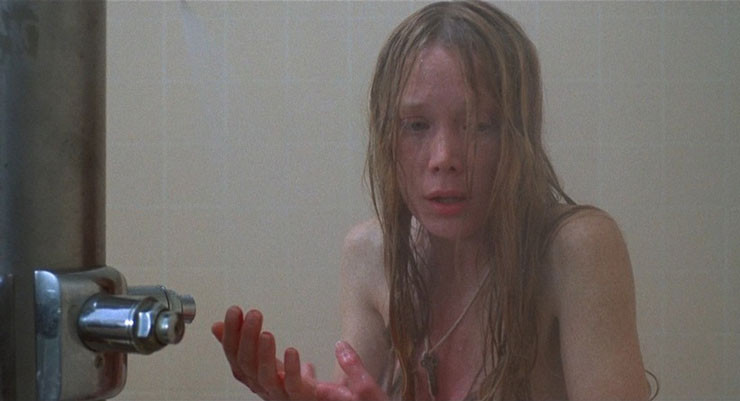
But that is about par for the course when it comes to me and Stephen King. I’m not a hundred percent sure of this, but there is a very good chance that the first adult novel I ever read (“adult” meaning “aimed at adults”, not “porn”) was Firestarter, originally published in 1980 (though I didn’t read it myself until a few years later). And since I distinctly remember being excited to realize that Firestarter’s heroine Charlie McGee was about my age (i.e. 8 or 9 years old), that means I was definitely way too young to be reading it—objectively, at least. Subjectively, though, I loved it to tiny itty bitty bits even if a lot of it flew over my head at the time, so I suspect child me would be telling adult me to get bent right about now. Sigh. Kids those days.
In any case, it is more or less impossible to overestimate the impact of Stephen King on the formative experiences of SF fans in my general age bracket. If you don’t believe me, look no further than the popularity of the new Netflix series Stranger Things, which has been aptly described as “every Stephen King novel in a blender”, run through an early Spielberg filter and then liberally soaked in nerdy Generation X nostalgia, served with a side of eldritch horror and awesomely horrible 80s fashion. The thrill I got when I saw that the title card was in the Stephen King font was really rather ridiculous. Needless to say, my sisters and I have all binged the crap out of this show, and its nostalgic awesomeness was at least partially the motivation for choosing to do Carrie for the MRGN at this juncture.
My point is, back in the day, Stephen King was the shit, y’all. At the height of his popularity, King was the best-selling novelist in the world, and over 100 of his various written works have been adapted for film and/or television. And of all of these, Carrie was the first—both his first published novel, in 1974, and the first work to be adapted for the screen, in 1976.
(It was also, I have just discovered, adapted as a Broadway musical in 1988, which I have trouble believing, and apparently has since become the gold standard for spectacular Broadway flops, which I have no trouble at all believing. Jeez.)
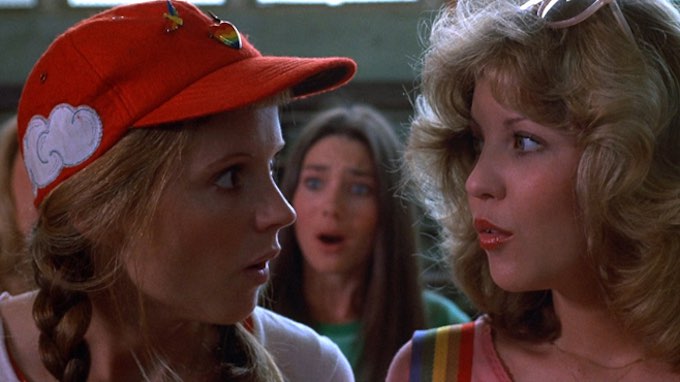
Anyway, Carrie’s position as a seminal work, of both King himself, and of the 40-years-and-counting tradition of adapting his stories into other formats, is another part of the reason why we chose it as the first (though almost certainly not the only) King-related film for the MRGN, despite my deep love of Firestarter. (The rest of the reason is that neither of my sisters has actually seen the film adaptation of Firestarter, nor have they read the book, and therefore campaigned successfully for Carrie instead. And it’s not like I was mad about doing Carrie, so here we are.)
Carrie was also the first mainstream commercial hit for director Brian De Palma, whose work you probably know even if you don’t recognize the name per se. De Palma’s films are characterized by a fondness for, among other things, unusual camera angles, 360-degree revolving shots, split-screen shots, and lots and lots (and lots) of slow motion. All of which are on full display in Carrie, that’s for sure.
His style is something that we felt, on watching it this time, was both an asset and a detriment to the film. On the one hand, the way the infamous prom crowning scene, unquestionably the pièce de résistance of the movie, was shot and edited was nothing short of masterful, in the way it generated almost unbearable tension and suspense leading up to the moment of Mean Girl Chris Hargensen’s revenge on Carrie, and then in the building horror of Carrie’s response. I still get chills every time I watch it, and I’m just gonna put the clip here because you know you want to watch it:
That said, for a lot of the rest of the time De Palma’s addiction to slomo and long, lingering shots frequently became pretty frustrating, especially toward the end; seriously, did we actually need to watch over a minute of Carrie just going up the front walk of her house? And as for 360-degree shots, the famous “first dance” spinning shot at the prom actually made us feel nauseated to watch. That, along with some other bizarre choices, like randomly choosing to “fast-forward” some of the dialogue in the tuxedo rental scene, were affectations that honestly I could have done without.
Granted, the over-leisurely pace was at least partially just a “movie made in the 70s” thing, because there are quite a few films from that decade which feel painfully slow from a modern perspective, but even given that, De Palma rather took it to extremes, I think. But then again, even with all the slomo, the film’s running time is barely over 90 minutes, so I suppose De Palma felt he had to do what he could to stretch it out, especially since he decided to exclude the epistolary interludes from King’s novel (which, ironically, King has said were his own way of padding out an otherwise very short book). Still, I feel like there’s a line between using a slow pace to build up suspense in your audience, and having that pace lose that tension to boredom, and Carrie crossed it a couple of times.
So there’s all that. But aesthetics of filmmaking aside, there is absolutely no way one can write an article about Carrie without having a conversation about its often deeply disturbing social implications. In particular as regards young women, of course, but also in terms of the almost inexplicably intense stranglehold that high school psychodrama holds over just about every American who’s ever attended one, male or female.
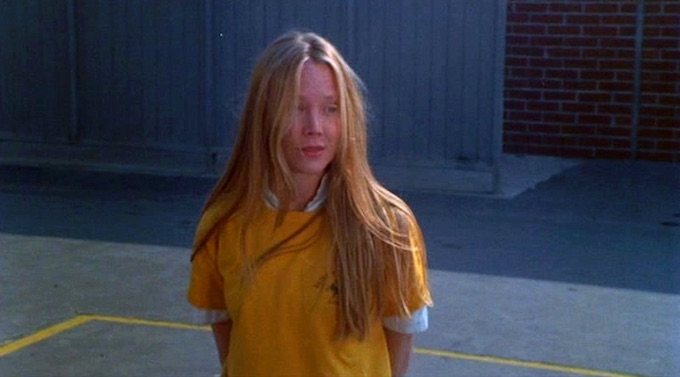
In his autobiography On Writing, King talks about how Carrie White was based on two of his own school classmates, and his observations of how they were relentlessly ostracized and/or bullied by the rest, for the unforgivable crime of deviating, voluntarily or otherwise, from an unspoken but utterly uncompromising perception of acceptability. In particular he talked about the seemingly contradictory yet nevertheless vicious response when one of those outcasts made an effort to break out of their imposed role, and conform to that very nebulous “norm” they were guilty of failing to be. It was a Catch 22, in other words: once pinned as the class loser, one could not be allowed to ever stop being the loser—perhaps because of the insight that, if you allow the lowest man on the totem pole to move up, that inevitably means that someone else would have to take her place, and that that someone just might be you. From that perspective it can almost be viewed as a sort of self-preservation instinct, callous as that sounds.
My and my sisters’ own experiences and/or observations of school bullying never quite reached the level of sheer cruelty displayed in Carrie, thank God, but I think it’s fairly telling that all three of us were instantly able to identify “the Carrie White” of our respective high school tenures—and the grammar school ones, too. I’m willing to bet that most of y’all reading this would be able to do the same. Perhaps some of you were the Carrie White of your school years. And if you were, please accept this virtual Internet hug from me, because that is a raw deal, my friends.
Part of the reason Carrie had such an impact is because of how, for all its fantastical trappings, it was rooted in things very real, mundane, and human as well—things that we could all, in one way or another, recognize as part of our own experiences. For the bullies, it was the horror of the idea that their victims might strike back at them tenfold; for the bullied, it was the disturbing but compelling allure of the idea of having the power to do so. It ain’t pretty, on either foot, but it rings true nevertheless.
TL;DR: High school is fucked up, y’all.
Then there’s the second cultural elephant in the room, represented by Carrie White’s utterly terrifying mother, and her gibbering, demented, and ultimately murderous take on religious fanaticism.
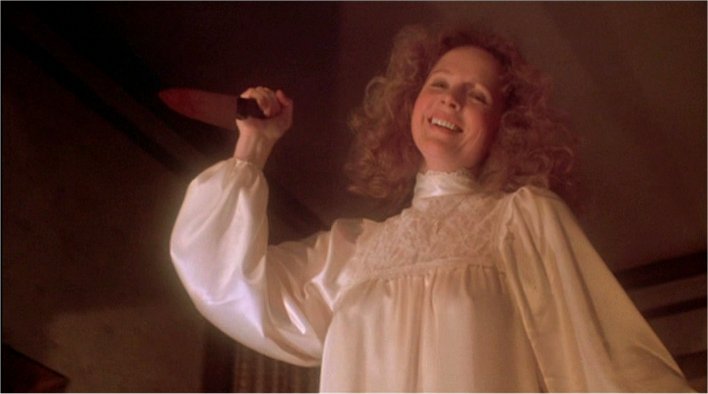
Eeeeeeeeeeeeeeeeeeeeeek
Needless to say, King has always had a distinctly dim view of those who, in his opinion, embrace piety at the expense of reason or compassion, and had no compunctions whatsoever about taking that tendency to its logical—and horrific—extreme for story-telling purposes. I wouldn’t say that his novels were the sole influence behind my own distaste for zealotry—I had plenty of real-life experiences which lent a hand there—but there’s no denying that characters like Margaret White made a significant impression on young me, and that impression was Do Not Want.
And lastly and probably most complicatedly, there is the feminist implications of Carrie, and the problematic lens it is (literally) viewed through.
I say that because, in my view, the sexist aspects of Carrie, the film, reside more or less wholly within the film itself, and hardly at all with the source material. It’s possible that I am biased here because of my general love for Stephen King’s books, but I feel that there is a subtle but unmistakable difference between the way King viewed Carrie and Sue and Chris and the other female characters in his novel, and the way De Palma depicted them in the film.
In his book, King was unquestionably tapping into the existence of gynophobic tendencies in our culture, like the unreasoning revulsion surrounding the issue of menstruation, for instance, or the hysterical (ha ha) emphasis placed on preserving some illusory and unsustainable version of female sexual purity that exists in many of the more hardline and/or fundamentalist religious traditions. Or even (more subtly) the persistence of the myth of constant and inevitable female rivalry, leading to the automatic disbelief by other characters that Sue Snell could ever possibly want to actually help Carrie instead of feel threatened by her.
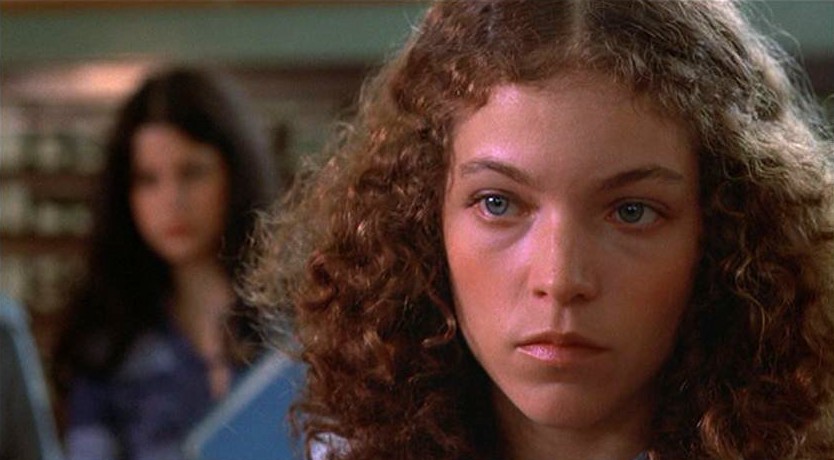
However, nothing he wrote there or since then has led me to conclude that King believes in these brands of misogyny, only that he accepts that they are real, and considers them to be harmful. Which is, after all, perfectly true.
Which is why it’s disappointing that the first good ten minutes of De Palma’s adaptation is devoted to shameless objectification of the female body, including of Carrie White’s, which is doubly gross in context. Granted, second wave feminism, which was prevalent throughout the 60s, 70s, and early 80s, was in fact deeply divided between those who were vehemently against anything that smacked of pornography or exploitation of women’s bodies, and those who endorsed a sex-positive version of feminism, which asserted that sexual freedom was an essential component of women’s freedom. I have no doubt that the “locker room” scene that opens Carrie was ostensibly geared toward the latter faction; however, let’s just say I have my suspicions of De Palma’s sincerity on that score.
I don’t know, it is a tangled and complicated question. But the thing is, whatever you would like to think about the locker room scene, the fact remains that from a plot development standpoint, up until Carrie actually starts bleeding, it was completely extraneous and unnecessary. Thus it is worth wondering what its actual purpose could have been, if not to ogle the bodies of underage girls.
But enough Deep Thoughts, let’s have some random commentary!
KATE: I never looked at a vegetable peeler the same way again.
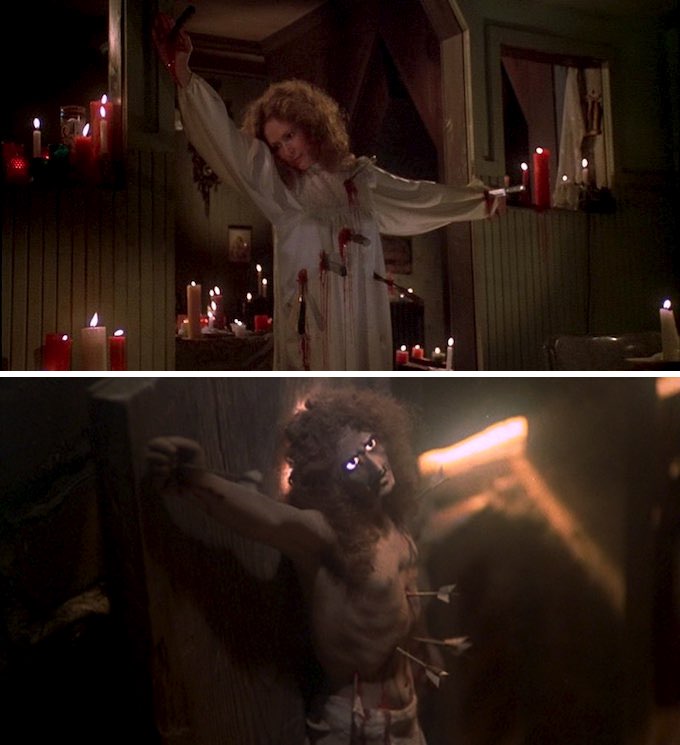
I debated bringing up the fact that there’s no way in hell (ha) Margaret’s body would have stayed in that position once she became dead weight, but on balance I figured that the artistic parallels to the WORLD’S SCARIEST JESUS FIGURE were too nice to spoil with nasty reality.
Seriously, there has never been a creepier Jesus statue in the history of ever. (And if there is a creepier Jesus out there, I DON’T WANT TO KNOW ABOUT IT. Shh!)
We also laughed (nervously) at Margaret’s mural of the Last Supper, in which every last apostolic participant looked like they were one coke snort away from a murder spree. Subtle, set designers.
It should be noted that one reason Carrie stands out among the general run of horror movies is the stellar performance of most of its cast, in particular Sissy Spacek as Carrie and Piper Laurie as her mother, both of whom received (well-deserved) Oscar nominations for their performances in the film. I distinctly remember watching this movie as a kid and just being in awe of Spacek’s acting during the prom scene. Like, I would never have thought anyone could be so frightening by just standing there, but Spacek was terrifying while barely moving a muscle.
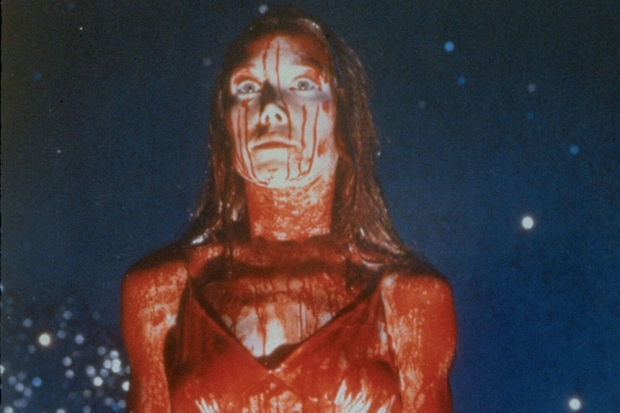
It was damn impressive then, and it still is now. And of course, Piper Laurie made your hair stand on end no matter what she was doing, which is equally impressive.
(In a funny turn of events, I realized belatedly that this is the second time Laurie has appeared in the MRGN: she also played Auntie Em in Return to Oz.)
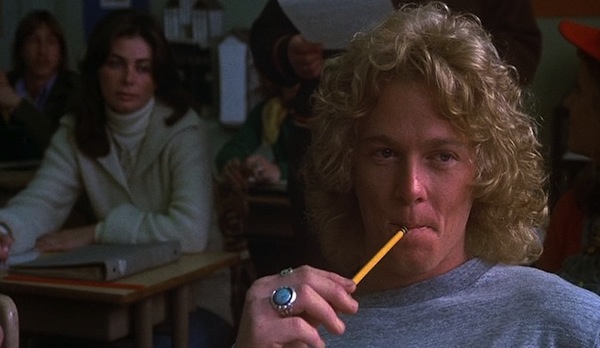
LIZ: OMG, that HAIR.
ME: I KNOW.
KATE: I can’t even with that hair.
LIZ: It’s like a LION’S MANE. It’s MAGNIFICENT. I HATE IT.
KATE: If I met someone with that hair I think I would have to back away from them, quickly.
We should probably take a moment, though, to be sad that Tommy Ross, the sole character in the entire movie who was completely blameless and innocent of any wrongdoing (as long as we don’t count the hair, natch), died so ignominiously and unfairly. You can have quite the debate over whether Carrie White holds any culpability for what she did at the prom, or if her state of being completely bugnuts at the time absolves her, but if there was going to be anything I would have held her responsible for, it’s Tommy.
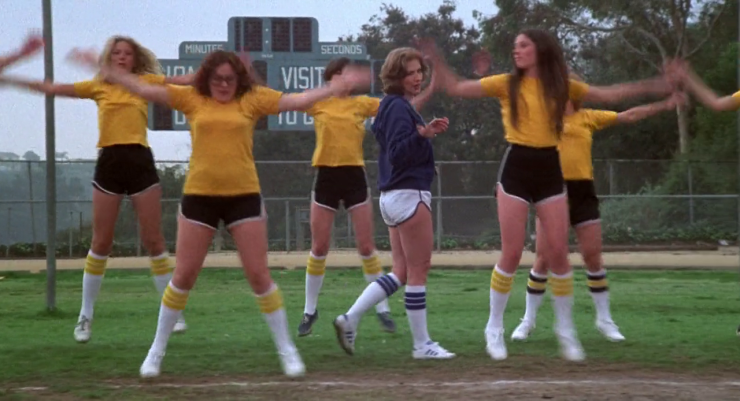
It was right about here that we had to pause the movie for a 10-minute discussion about socks. We were all too late for the stupendousness of these particular socks, but we debated fiercely about wigwam versus bobby and which ones sucked more to wear in P.E., until my grandmother trumped us all with tales of the nylon stockings and actual freakin’ bloomers she had to wear for gym class, whereupon we conceded defeat and resumed the film.
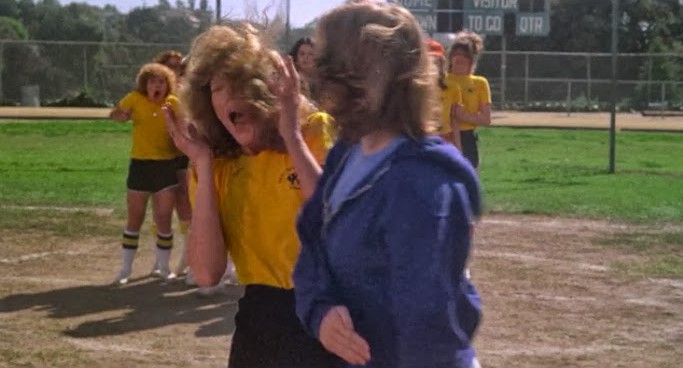
ME: Holy shit.
LIZ: Right? If a teacher did that today she would be so fired.
ME: Fired? She would be arrested. And sued. Her life would be frickin’ over.
KATE: Truth.
There was a disconcerting amount of face-slapping all around in this movie, in fact, but not a single one of them startled me as much as this one. Not even when John Travolta’s Billy Nolan slapped Chris.
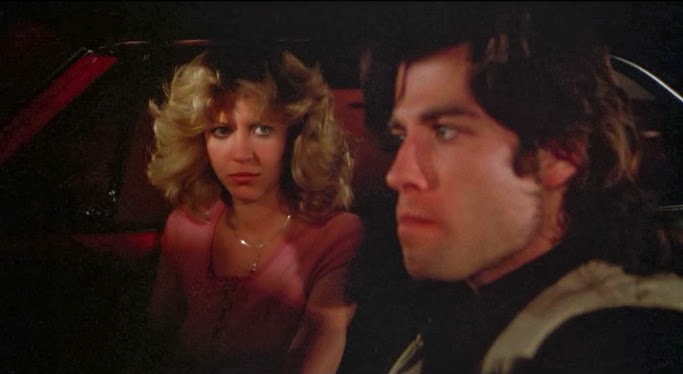
There is an entire essay I don’t have time for on the deeply messed up character of Chris Hargensen, and how I both loathe the stereotypes she represents and regretfully recognize the reality of the existence of girls like her, and the conflicted feelings I have about being so happy when Carrie kills the shit out of her at the end of the movie.
LIZ: That’s not as scary as I remember it being.
ME: OMG WHAT IS YOUR DAMAGE
I argued to her that it just wasn’t as scary because she was expecting it this time, but she remains unconvinced. I think she may be history’s greatest monster. Or, you know, something proportional like that.
In conclusion, while I have rather more issues with the movie than I thought I would, I still love it, and think that even with its flaws it absolutely deserves a place of honor in the horror genre. I know it’s been remade several times since the 1976 version, but frankly I never had the slightest interest in watching any of them. Nothing is ever going to beat the Sissy Spacek version of the prom scene, sorry.
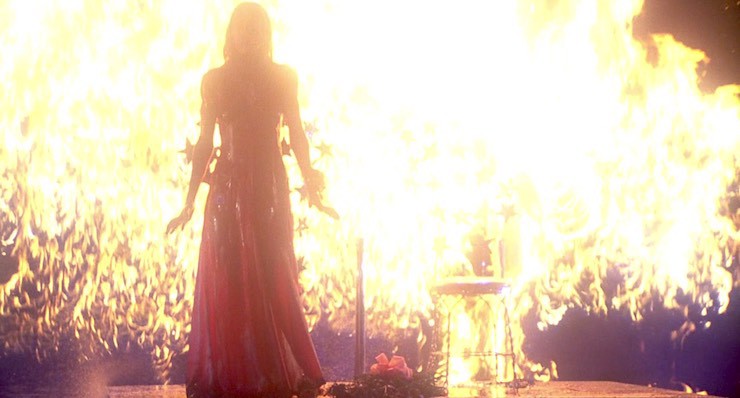
And thus concludes my journey down memory lane for the nonce! And as always, we end with my fabulous Nostalgia Love to Reality Love 1-10 Scale of Awesomeness!
Nostalgia: 9
Reality: 8
And that’s it for the Nostalgia Rewatch for now, kids! Come back in two weeks, when we will be covering… er. Well, I just realized we haven’t settled on that yet but now we have, and it’s – drumroll, please – Legend! Unicorns! Infant Tom Cruise! Tim Curry as Satan! OMG! Until then, cheers!










